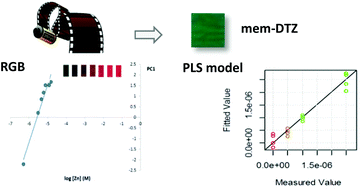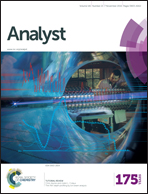Smart sensory materials for divalent cations: a dithizone immobilized membrane for optical analysis†
Abstract
An optode for Cu(II), Cd(II), Zn(II) and Hg(II) sensing has been designed by immobilization of dithizone on a triacetylcellulose membrane (mem-DTZ). The sorption of the metal ions on the mem-DTZ has been thoroughly characterized, in particular sorption kinetics, sorption isotherms and profiles as a function of the pH have been studied. Methods to assess the concentrations of the cations, both individually and in a mixture, in unknown samples, have been developed. In particular, UV-vis spectra and digital information of pictures taken by using a common desktop scanner, of the mem-DTZ sensor after equilibration with different solutions, were acquired and they were correlated with the concentration of the metal ions in solutions. For the single analyte determination, the RGB parameters of the pictures were subjected to Principal Component Analysis (PCA); otherwise the UV-vis spectra of a mixture of two cations were elaborated by Partial Least Squares (PLS) Regression. The membrane responds to the divalent cations by changing colour reversibly. The response time of the mem-DTZ is about 1 h for Cd(II), Hg(II) and Zn(II), but longer for Cu(II): more than 10 h are required. The linear interval is in the range of about 10−7 to 10−5 M for all metal ions. The limit of detection (LOD) is around 10−6 M for Cu(II), Cd(II) and Hg(II); for Zn(II) a lower LOD of 10−7 M is obtained. The applicability of mem-DTZ to real samples has been proved by analysis of the four metal cations in a certificate material (Sewage Sludge CC136A), white wine, and drinking water samples.


 Please wait while we load your content...
Please wait while we load your content...